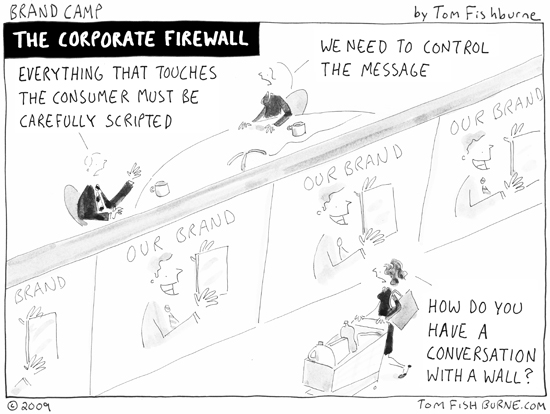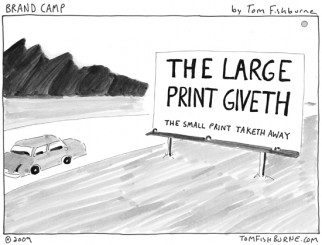I recently stumbled across the cluetrain manifesto again. It had a big impact on me when I first read it ten years ago. At the time, I was building web sites for big companies and it gave voice to a lot of the frustration I felt trying to get these companies to really embrace the potential of engaging with consumers directly.
I worked with an airline that refused to handle any consumer inquiries generated by their web site. They actually had an in-house call center for reservations, but didn’t even want their phone number listed on the site (let alone an email address). For them, the web site was a cheaper way to book reservations, and they were trying to lower transaction costs, not increase consumer loyalty.
This was particularly odd because the airline prided itself on in-flight customer service.
Reading the cluetrain manifesto, I was struck by the metaphor of the “corporate firewall”: “Markets do not want to talk to flacks and hucksters. They want to participate in the conversations going on behind the corporate firewall.”
This airline (and many companies) had erected a strict corporate firewall that barred the majority of consumer interactions and only let out carefully scripted marketing messages. Loyalty was achieved through frequent flyer miles: essentially buying loyalty rather than earning it.
Ten years later, the 95 theses of the cluetrain manifesto feel prescient now that the tools for social media are commonplace. Social media is part of every marketing plan. Yet, I question how much the corporate firewall has actually changed.
Using social media without first re-evaluating the corporate firewall feels like the same old window dressing. It’s today’s brochureware. It doesn’t achieve the potential that these tools were designed to achieve.
There is an opportunity for companies that tear down (or at least reevaluate and modernize) the corporate firewall. For those that don’t, the cluetrain manifesto offers this caution:
Companies make a religion of security, but this is largely a red herring. Most are protecting less against competitors than against their own market and workforce.



Glennfriesen says
Wow. Thank you, thank you, thank you for introducing me to the cluetrain manifesto — I hadn’t ever heard of it before, and now, I’m glued. Surprised this document’s not referenced even more!
What really stuck with me is how absolutely true your ending quotation is: “Companies make a religion of security, but this is largely a red herring. Most are protecting less against competitors than against their own market and workforce.”
Thanks again for the reference and inspiration —
@GlennFriesen
http://www.impactlearning.com/